高等流体力学第一篇introduction
- 格式:pdf
- 大小:4.74 MB
- 文档页数:61




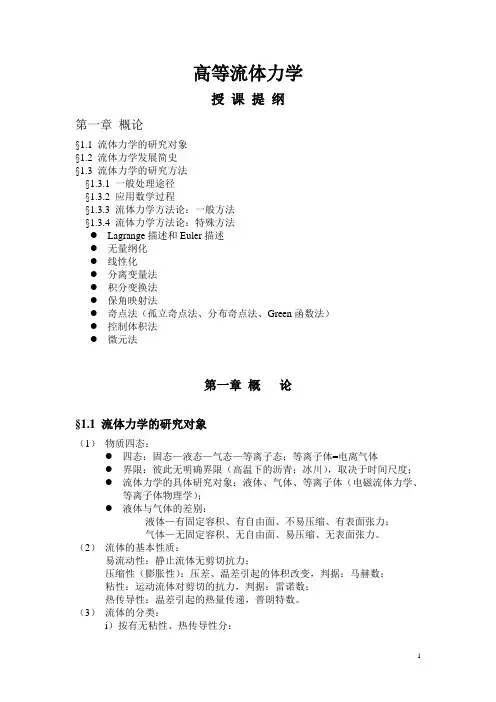
高等流体力学授课提纲第一章概论§1.1 流体力学的研究对象§1.2 流体力学发展简史§1.3 流体力学的研究方法§1.3.1 一般处理途径§1.3.2 应用数学过程§1.3.3 流体力学方法论:一般方法§1.3.4 流体力学方法论:特殊方法●Lagrange描述和Euler描述●无量纲化●线性化●分离变量法●积分变换法●保角映射法●奇点法(孤立奇点法、分布奇点法、Green函数法)●控制体积法●微元法第一章概论§1.1 流体力学的研究对象(1)物质四态:●四态:固态—液态—气态—等离子态;等离子体=电离气体●界限:彼此无明确界限(高温下的沥青;冰川),取决于时间尺度;●流体力学的具体研究对象:液体、气体、等离子体(电磁流体力学、等离子体物理学);●液体与气体的差别:液体—有固定容积、有自由面、不易压缩、有表面张力;气体—无固定容积、无自由面、易压缩、无表面张力。
(2)流体的基本性质:易流动性:静止流体无剪切抗力;压缩性(膨胀性):压差、温差引起的体积改变,判据:马赫数;粘性:运动流体对剪切的抗力,判据:雷诺数;热传导性:温差引起的热量传递,普朗特数。
(3)流体的分类:i)按有无粘性、热传导性分:真实流体(有粘性、有热传导、与固体有粘附性无温差);理想流体(无粘性、无热传导、与固体无粘附性有温差);ii)按压缩性分:不可压缩流体,可压缩流体;iii)按本构关系分:牛顿流体(牛顿粘性定律成立),非牛顿流体(牛顿粘性定律不成立),下分纯粘性流体(拟塑性流体,涨塑性流体);粘塑性流体(非宾汉流体、宾汉流体);时间依存性流体(触变流体、振凝流体);粘弹性流体拟塑性流体(剪切流动化流体):剪切应力随剪切速度增加而减小,如淀粉浆糊、玻璃溶液、高分子流体、纤维树脂;涨塑性流体(剪切粘稠化流体):剪切应力随剪切速度增加而减小,如淀粉中加水、某些水-砂混合物;粘塑性(非宾汉和宾汉流体):存在屈服应力,小于该应力无流动,如粘土泥浆、沥青、油漆、润滑脂等,所有粘塑性流体为非宾汉流体,宾汉流体为近似;触变流体(摇溶流体):粘性或剪切应力随时间减小,如加入高分子物质的油、粘土悬浊液;振凝流体:粘性或剪切应力随时间增大,如矿石浆料、膨润土溶胶、五氧化钒溶液等;粘弹性流体:兼有粘性和弹性性质的流体,能量不像弹性体守恒,也不像纯粘性体全部耗散。
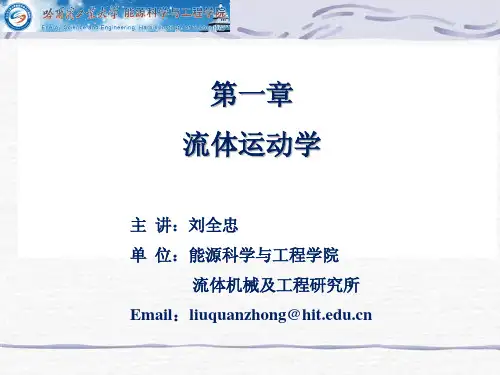
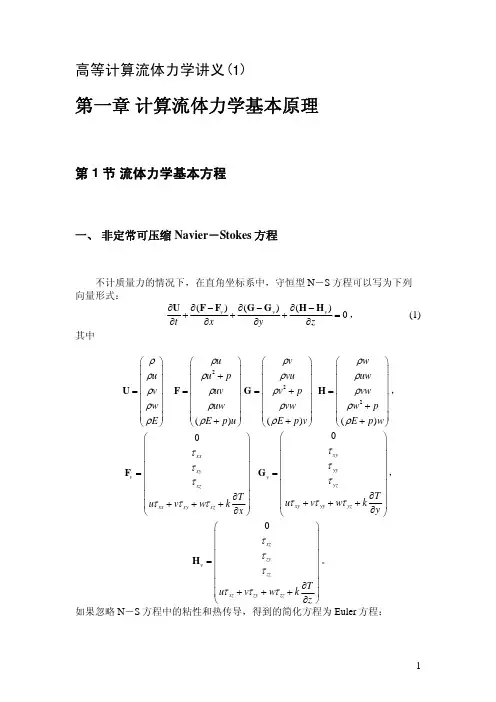
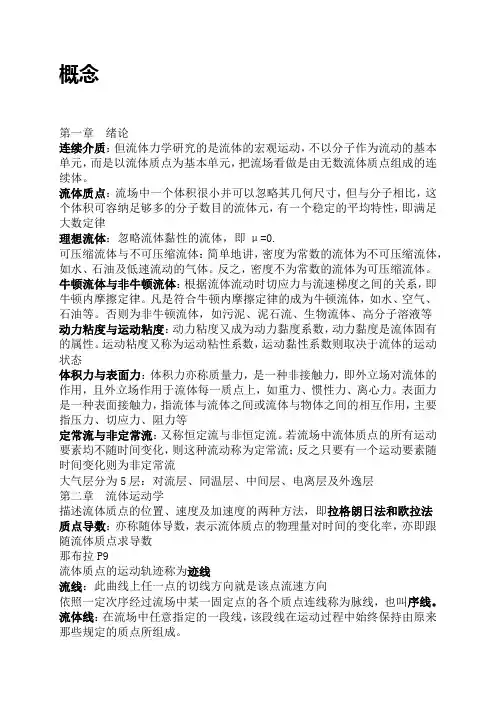
概念第一章绪论连续介质:但流体力学研究的是流体的宏观运动,不以分子作为流动的基本单元,而是以流体质点为基本单元,把流场看做是由无数流体质点组成的连续体。
流体质点:流场中一个体积很小并可以忽略其几何尺寸,但与分子相比,这个体积可容纳足够多的分子数目的流体元,有一个稳定的平均特性,即满足大数定律理想流体:忽略流体黏性的流体,即μ=0.可压缩流体与不可压缩流体:简单地讲,密度为常数的流体为不可压缩流体,如水、石油及低速流动的气体。
反之,密度不为常数的流体为可压缩流体。
牛顿流体与非牛顿流体:根据流体流动时切应力与流速梯度之间的关系,即牛顿内摩擦定律。
凡是符合牛顿内摩擦定律的成为牛顿流体,如水、空气、石油等。
否则为非牛顿流体,如污泥、泥石流、生物流体、高分子溶液等动力粘度与运动粘度:动力粘度又成为动力黏度系数,动力黏度是流体固有的属性。
运动粘度又称为运动粘性系数,运动黏性系数则取决于流体的运动状态体积力与表面力:体积力亦称质量力,是一种非接触力,即外立场对流体的作用,且外立场作用于流体每一质点上,如重力、惯性力、离心力。
表面力是一种表面接触力,指流体与流体之间或流体与物体之间的相互作用,主要指压力、切应力、阻力等定常流与非定常流:又称恒定流与非恒定流。
若流场中流体质点的所有运动要素均不随时间变化,则这种流动称为定常流;反之只要有一个运动要素随时间变化则为非定常流大气层分为5层:对流层、同温层、中间层、电离层及外逸层第二章流体运动学描述流体质点的位置、速度及加速度的两种方法,即拉格朗日法和欧拉法质点导数:亦称随体导数,表示流体质点的物理量对时间的变化率,亦即跟随流体质点求导数那布拉P9流体质点的运动轨迹称为迹线流线:此曲线上任一点的切线方向就是该点流速方向依照一定次序经过流场中某一固定点的各个质点连线称为脉线,也叫序线。
流体线:在流场中任意指定的一段线,该段线在运动过程中始终保持由原来那些规定的质点所组成。
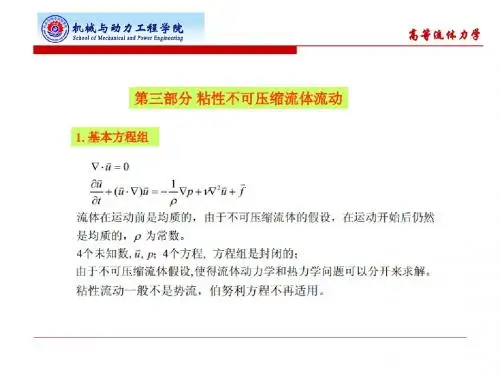
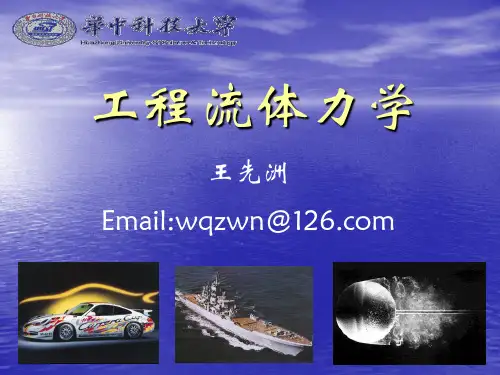
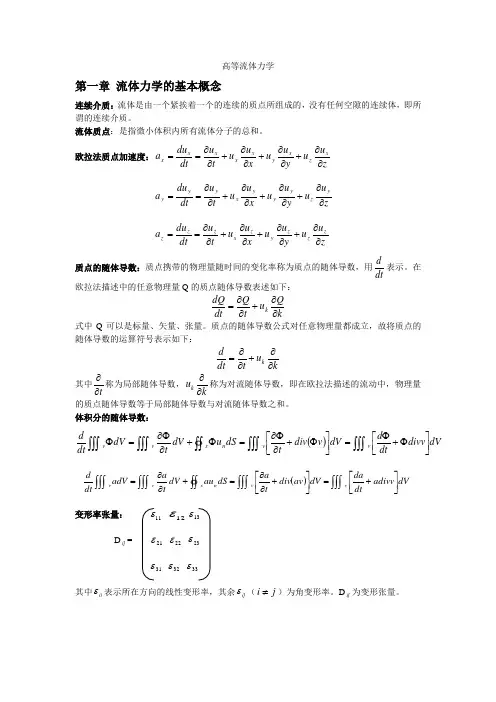
高等流体力学第一章 流体力学的基本概念连续介质:流体是由一个紧挨着一个的连续的质点所组成的,没有任何空隙的连续体,即所谓的连续介质。
流体质点:是指微小体积内所有流体分子的总和。
欧拉法质点加速度:zuu y u u x u u t u dt du a x z x y x x x x x ∂∂+∂∂+∂∂+∂∂==zu u yu u xu u tu dtdu a y zy yy xy y y ∂∂+∂∂+∂∂+∂∂==zu u y u u x u u t u dt du a z z z y z x z z z ∂∂+∂∂+∂∂+∂∂==质点的随体导数:质点携带的物理量随时间的变化率称为质点的随体导数,用dtd表示。
在欧拉法描述中的任意物理量Q 的质点随体导数表述如下:kQu t Q dt dQ k ∂∂+∂∂= 式中Q 可以是标量、矢量、张量。
质点的随体导数公式对任意物理量都成立,故将质点的随体导数的运算符号表示如下:ku t dt d k ∂∂+∂∂= 其中t ∂∂称为局部随体导数,ku k ∂∂称为对流随体导数,即在欧拉法描述的流动中,物理量的质点随体导数等于局部随体导数与对流随体导数之和。
体积分的随体导数:()dV divv dt d dV v div t dS u dV t dV dt d v v n s v v ⎥⎦⎤⎢⎣⎡Φ+Φ=⎥⎦⎤⎢⎣⎡Φ+∂Φ∂=Φ+∂Φ∂=Φ⎰⎰⎰⎰⎰⎰⎰⎰⎰⎰⎰⎰⎰⎰()dV adivv dt da dV av div t a dS au dV t a adV dt d v v n s v v ⎥⎦⎤⎢⎣⎡+=⎥⎦⎤⎢⎣⎡+∂∂=+∂∂=⎰⎰⎰⎰⎰⎰⎰⎰⎰⎰⎰⎰⎰⎰ 变形率张量: 11ε 12ε13εD ij = 21ε 22ε 23ε31ε 32ε 33ε其中ii ε表示所在方向的线性变形率,其余ij ε(j i ≠)为角变形率。
D ij 为变形张量。
⎪⎪⎭⎫⎝⎛∂∂+∂∂=i j j i ij x u x u 21ε 旋转角速度: 0 z ω- y ωR ij =z ω 0 x ω-y ω- x ω 0z ω=⎪⎪⎭⎫ ⎝⎛∂∂-∂∂y u x u x y 21y ω=⎪⎭⎫⎝⎛∂∂-∂∂x u z u z x 21x ω=⎪⎪⎭⎫ ⎝⎛∂∂-∂∂z u y u y z 21 判断有旋流和无旋流:x ω=y ω=z ω=0,z ω=⎪⎪⎭⎫ ⎝⎛∂∂-∂∂y u x u x y 21=0,y ω=⎪⎭⎫⎝⎛∂∂-∂∂x u z u z x 21=0 x ω=⎪⎪⎭⎫⎝⎛∂∂-∂∂z u y u y z 21=0 ,y u x u x y ∂∂=∂∂x u z u z x ∂∂=∂∂,z u y u yz ∂∂=∂∂ 涡量与速度环量的关系:涡量,流体力学中多用涡量来表示流体微团的旋转。
高等流体力学Advanced Fluid Mechanics主讲:余永亮中国科学院大学工程科学学院,北京100049Chapter 2 Viscous Fluid Motion§2.1 Introduction•Governing Equations•Conditions of the definite solutions of Navier-StokesEquations•Mathematical Properties of Navier-Stokes Equations •Similarity Parameters1. Governing Equations (1) Continuity Equation(2) Dynamics(Kinetics) EquationConstitutive Relation:For incompressible flow,Navier-Stokes Equation (incompressible)Internal Energy1. Governing Equations(3) Energy EquationFourier ’s Law Viscous dissipation functionTotal kinetic energy (incompressible and uniform fluid)The change rate of the total kinetic energyTotal kinetic energy (incompressible and uniform fluid)The change rate of the total kinetic energy=0, for an isolated systemTotal kinetic energy (incompressible and uniform fluid)The change rate of the total kinetic energyThe viscosity coefficient is always positiveThe second law ofthermodynamics1. Governing Equations (*) State EquationThis set of equations is complete!2. Conditions of the definite solution of N-S-E •Boundary Condition + Initial Condition•Physical law•Mathematical propertiesFor Euler equationAt the solid boundary(1) Solid BoundarySuppose : No mass exchange at the solid surface Boundary Condition: Non-slip condition(Adhesive Con.)the boundary condition can not be provedthe boundary conditions are conditional!For porous surfaces, there is mass exchange(2) Free Surface(2) Free SurfaceKinematic condition:(2) Free SurfaceDynamic condition:I. No surface TensionII. With surface Tension(3) Energy Condition Notice: For viscous flows, we don’trecognize there exists discontinuityin the flow field.•PDEs (partial differential equations) with 2 independent variablesAll coefficients are sufficiently smoothe.g. 1D waveInitial value:Exact solution:characteristic equationStrictly Hyperbolic Equations(狭义双曲型方程组): there are Ndifferent real roots of this equation at every point (real eigenvalues)Elliptic Equations(椭圆型方程组): there is no real roots of thisequation at every point.•The standard form of the second-order partial differential equationsWhere A,B,C,D are the function ofBoundary-value problemInitial and Boundary-value problemInitial and Boundary-value problemInitial-value problem•Three typical types of equationsPoisson Eqn. ---EllipticHeat Conduction Eqn. ---ParabolicWave Eqn. ---Hyperbolic•The simplified Navier-Stokes equations (No convective term, Uniform fluid, Mass force has a potential)àElliptic equationàParabolic equation Euler Equations for steady flow:Ma>1, à4 real rootsàHyperbolic EquationsMa=1, à2 group of real roots àParabolic-Hyperbolic EquationsMa<1,à1 pair of complex roots àElliptic-Hyperbolic EquationsEuler Equations for steady flow:Ma>1, à4 real rootsàHyperbolic EquationsMa=1, à2 group of real roots àParabolic-Hyperbolic Equations Ma<1,à1 pair of complex roots àElliptic-Hyperbolic Equations4. Similarity Parameters (1) Flow quantities:They are dependent on:(2) The Fundamental Dimensions:The fundamental dimensionsReference quantities:Specific-heat ratio of eight common gases as a function of temperatureReference quantities:Reference quantities:incompressible flow, where density effects are negligible.subsonic flow, where density effects are important but no shockwaves appear.transonic flow, where shock waves first appear, dividing subsonicand supersonic regions of the flow. Powered flight in the transonic region is difficult because of the mixed character of the flow field.supersonic flow, where shock waves are present but there are nosubsonic regions.hypersonic flow, where shock waves and other flow changes areespecially strong.incompressible flow, where density effects are negligible. subsonic flow, where density effects are important but no shockwaves appear.transonic flow, where shock waves first appear, dividing subsonicand supersonic regions of the flow. Powered flight in the transonic region is difficult because of the mixed character of the flow field.supersonic flow, where shock waves are present but there are nosubsonic regions.hypersonic flow, where shock waves and other flow changes areespecially strong.•Similarity of molecular transport processes•Similarity of flow processes•Similarity of heat transfer processesNatural convection•Similarity of integral quantities of forces•Similarity of integral quantities of heat and mass transferheat transfer coefficientmass transfer coefficientReynolds number(1) Flow constructureReynolds number, as the similarity parameter of viscous flow, has very important position in analyzing the flow.Reynolds number (2) Reynolds number and Drag(2) Reynolds number and Drag(2) Reynolds number and Drag(2) Reynolds number and DragTime history of Aerodynamic drag of cars in comparison withchange in geometry of streamlined bodies (bluff to streamline).Reynolds number(3) Reynolds number and the flight mode (Fixed wing?)。